Vanessa Alaimo sits in her freshman dorm, stress building by the moment as she types desperately on her laptop.
She’s just received a rejection email from the University of South Carolina’s housing department – they won’t have a bed for her next year – and she’s growing frantic, not knowing where she’ll live come fall and quickly trying to figure out her options. It’s only February, but already her choices are limited.
She’s combing through apartment websites, but many off-campus student apartments have already sold out of leases. The ones closest to campus, such as Greene Crossing, The Hub and The Station, have but a few spots left.
The more Alaimo searches, the more she worries. Questions like, “How will I afford monthly rent?” and “Will my financial aid help?” start flooding her mind.
She’s running out of time to find her next home. And she’s not the only one struggling.
Each year, thousands of students at South Carolina’s flagship university scramble to find places to live in the heart of the capital, often forced to make difficult – and quick – choices between high-priced, newly built private apartments downtown or cheaper but sometimes poorly maintained housing farther from classes and campus life. All the while, USC doesn’t come close to providing enough beds for its 28,429 undergraduates and in recent years has done little to make up for the shortage of housing available for its ever-growing student body.
Despite growing its student body by more than 9,000 over the past 15 years, USC’s on-campus housing stock has only increased by some 2,840 beds in roughly the same time. Just over a third of USC students are able to live on campus, meaning the majority of the rest are pushed into the greater Columbia area, combing for rentals.
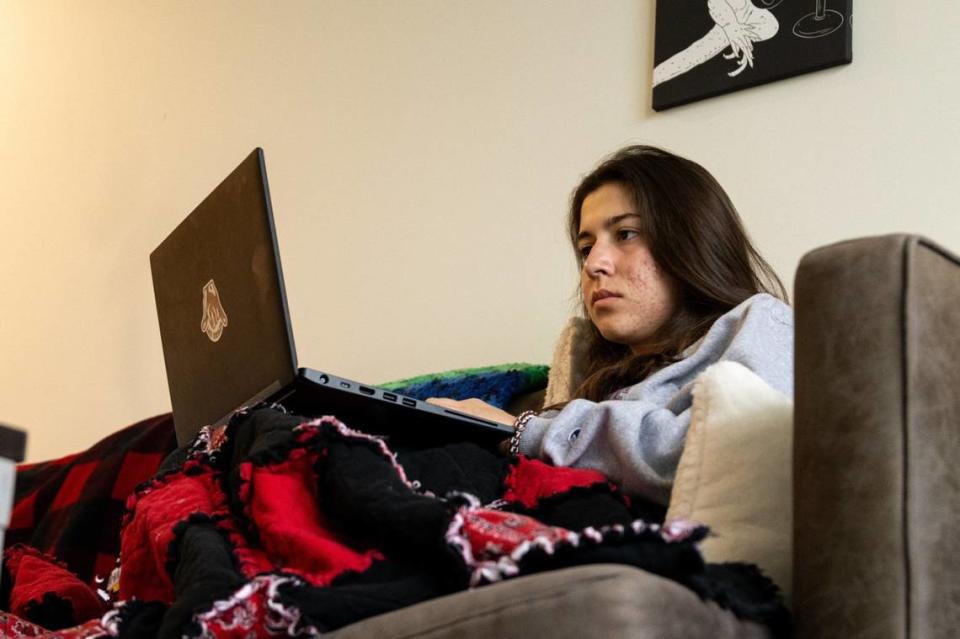
The discrepancy between students and beds has generated a wave of private student apartment construction in recent years, with many developments taking advantage of generous public tax incentives that have been offered specifically to address the severe need for beds for USC students. Since 2014, at least a dozen private apartment developments – most of them explicitly marketed to USC students – have sprung up or are actively being built within 1-2 miles of USC’s Horseshoe, the traditional heart of campus.
Rents at downtown student apartments range from around $800 to more than $1,600 per room per month, compared to an average market rate rent of $1,200 per apartment for the average Columbia renter, according to the firm Colliers.
The student apartments are marketed with luxury amenities ranging from swimming pools to gyms to study rooms that all come with a price and are often known to fall into disrepair.
Several of them are also known to be hotspots for thefts and security breaches – all happening beyond the gaze of university officials, who offer limited housing support for students living off-campus.
Is USC doing enough to manage the housing needs of its students, or is its hands-off approach fostering an untenable renting environment?
The university finished building its new Campus Village dormitory complex in August, just in time for its largest freshman cohort ever. The class of 2027, which exceeded 7,000 students for the first time, was hundreds more than initially expected.
Campus Village, which includes four residence halls, a dining hall and retail spaces, was nearly a decade in the making and the largest construction project in USC’s history. The massive development on Sumter and Whaley streets is home to approximately 1,800 students.
It was supposed to alleviate housing problems. Or at least some of them.
But the $240 million state-of-the-art facility was a mere fix for the university’s recent shortfall, after some students had to be put up in hotels a year prior. And today, the university isn’t poised to get ahead of future growth.
‘How am I going to afford to stay here?’
Freshmen already begin to flock to off-campus apartment complexes in September and October, only weeks after starting their first college classes, hoping to secure a place to live nearly a full year in the future. The longer they wait, the less likely they are to find an affordable and safe apartment.
This past fall, Alaimo toured 21 Oaks apartments near Williams-Brice Stadium, the Lofts on south Main Street and the Hub downtown, but none met her expectations. She wanted the employees to be honest with her, she said. They instead met her with “lavish amenities,” which brought in additional fees.
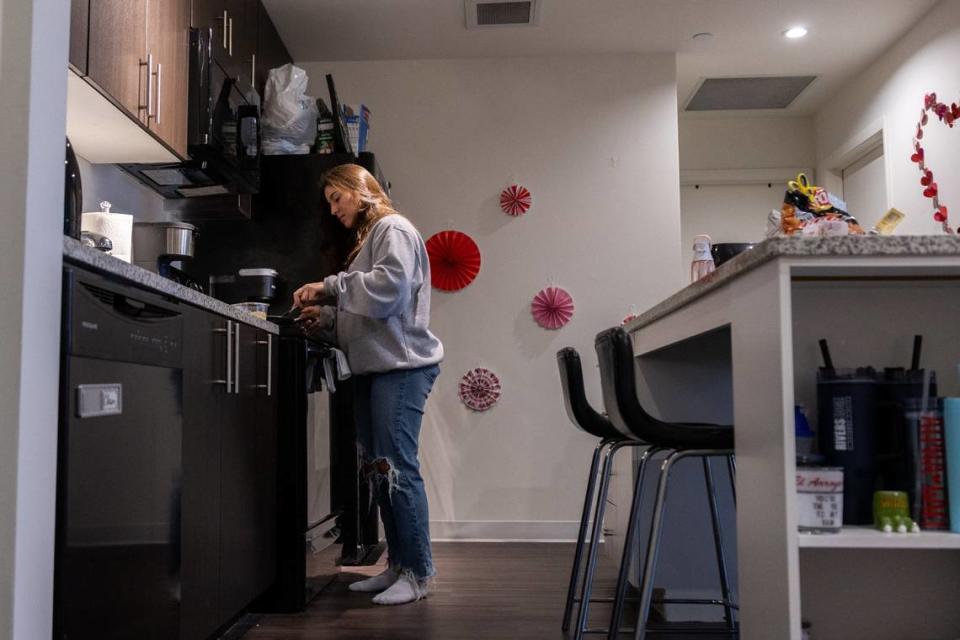

A tour that started out advertising a two-bedroom apartment for $750 quickly became more than $1,000 per month for add-ons such as parking and a porch, she said.
Sure, there were cheaper options. But those were farther away from campus and didn’t have glowing reviews from other students, Alaimo found.
“It was kind of crazy to me that they expect college students to afford $1,200 a month just to be in a safe, nice location,” Alaimo said.
Moving off campus wasn’t Alaimo’s first choice. And the same goes for many USC students looking beyond their freshman years.
USC requires freshmen to live on campus their first year and has 17 residence halls to accommodate the population. About 7,344 freshmen were housed on campus for 2023-24.
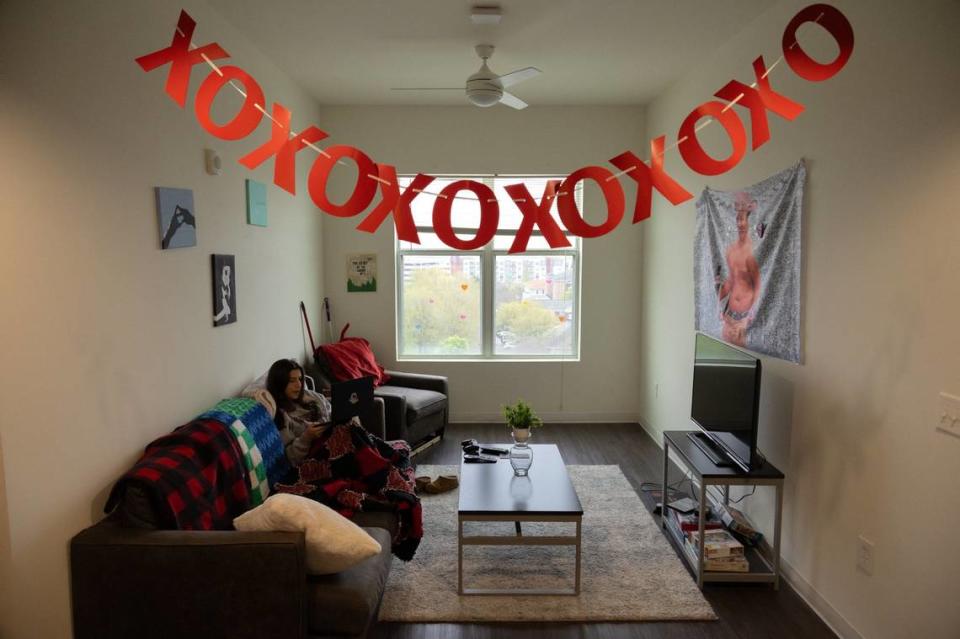

But students who want to continue living on campus in their sophomore year have relatively few options. Eight campus buildings are available to upperclassmen, but seven of those choices are reserved for just Honors College students, Capstone Scholars and students who are part of other living-and-learning communities.
Any other freshman who wants to live on campus their sophomore year only has one option: the 649-bed Park Place apartments, which were originally built in 2016 at the corner of Blossom and Huger streets as private off-campus apartments but were absorbed by the university in 2017, in part to help meet demands for on-campus housing. Park Place contains mainly upperclassmen, but the university does not reserve the beds just for them.
More than 2,400 current students have applied to live on campus as upperclassmen in the fall, according to university spokesperson Collyn Taylor. The university is unsure how many will be granted housing.
In Alaimo’s case, she applied in October of her freshman year to become a resident assistant – a paid university housing position that would also guarantee on-campus housing – and, come January, applied separately for on-campus housing as a backup. In February, she was rejected from both.
But in the meantime, many private off-campus apartment rooms had already been snapped up, still more than half a year before the next academic year begins.
“My first thought was, ‘How am I going to afford to stay here (at USC)?’” Alaimo said. “I felt like it was a lot of wasted time because to go through all that whole process. I mean, it’s very disappointing.”
Downtown development boom
In 2014, as the student population in Columbia continued to climb, city leaders saw an opening.
“We knew there would be a significant need for more student housing,” said Steve Benjamin, Columbia’s mayor at that time. But the move was also strategic, he added, to increase the number of private entities paying taxes – a limited opportunity in a government town.
So to boost the tax rolls and to help the university meet the growing demand for student housing, the city along with Richland County in 2014 granted developers of student housing projects a 50% tax break for 10 years in exchange for investments of at least $40 million.
In a matter of years, downtown was flush with new student housing, with thousands of residents spread across incentivized projects such as the 724-bed Greene Crossing apartments in the Vista, the six-story, 650-bed Empire apartments on Assembly Street, and the 660-bed Station at Five Points development slightly farther away from campus.
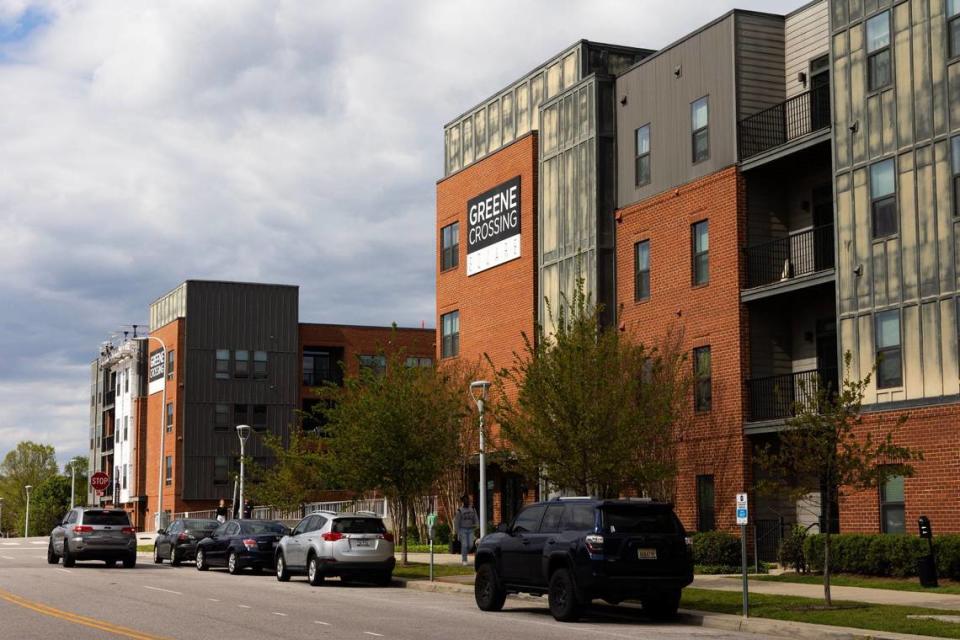

Plus, other projects not included in the incentives program, like the 847-bed The Hub, also came online. The first city-county tax incentive program for student housing only lasted a few years, but the private apartment wave – and tax breaks for new projects – have continued.
Today, a 940-bed apartment project dubbed Gadsden + Greene is being developed by the university’s development foundation near Colonial Life Arena, and a 700-bed private development named Verve Columbia is in the planning stages for the intersection of Blossom, Huger and Wheat streets near the USC baseball stadium.
The newer downtown apartments offer nicer amenities than their older counterparts, but they also come with higher rents. And despite those rents, residents and their parents say they don’t always feel like they’re getting what they pay for.
Students have complained about faulty air-conditioning, insufficient Wi-Fi and a lack of communication from management companies, which have been known to change frequently through the years.
At The Station, for example, residents said they dealt with trash in the hallways after the floor’s trash shoot would pile up. And at Greene Crossing, students said it would take anywhere from two weeks to over a month to fix utilities.
“(Management was) very very rude when you asked or confronted them about any issues,” Greene Crossing resident Rae Jones, a USC junior, said. “It’s not unreasonable to expect to have the things that you pay for in your home.”
And incident reports from the Columbia Police Department show safety and security also have been issues at certain downtown properties.
Twice at the end of 2021 – once in November and once the day before Christmas – residents at The Station at Five Points were robbed at gunpoint.
At Greene Crossing, one person in late 2021 reported being violently assaulted while waiting for a friend at the property’s parking lot. An unknown person got into the car, beat him and robbed him at gunpoint, according to an incident report from the police department.
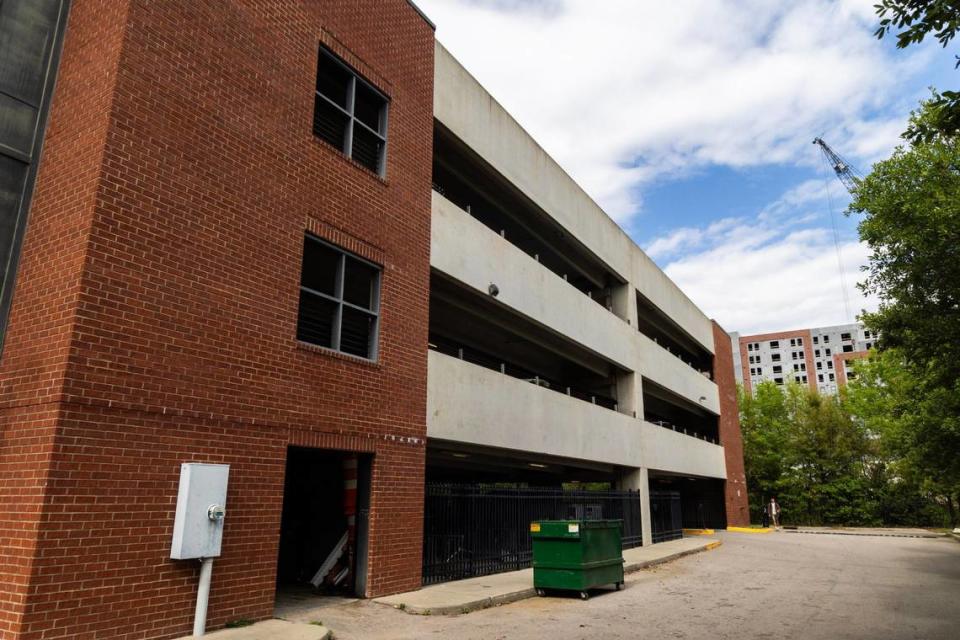

The majority of the incident reports obtained by The State and The Daily Gamecock were not for violent crimes, but auto-break ins and other thefts were common. Columbia Police Captain Cynthia Waggoner agreed that auto break-ins are the top crime problem at student apartments.
“It’s exciting to see the growth,” Waggoner said of the influx of student apartments downtown. But, “it has created some challenges … as we learn to interact with a large, younger population.”
At Greene Crossing on Pulaski Street, 31 incident reports were taken by police between January 2021 and November 2023. Roughly 40% of those incidents involved an auto break-in or some other incident involving the apartment’s parking garage.
In one 2022 incident, two people entered the parking garage at the apartment complex and stole a golf cart, in addition to tools and HVAC parts.
Greene Crossing’s property manager, Amanda Williams, said that since ownership changed at the apartments in 2022, management has added a handful of new security features, including fobs for entry into the parking garage.
Two Columbia police officers also live at Greene Crossing, serving as “courtesy officers” who do nightly patrols of the property and report directly to Williams, she said.
Waggoner said most student apartments downtown do have courtesy officers, like Greene Crossing. She also said any apartment complex can request a courtesy officer live at their property, not just downtown student apartments.
Another issue student apartments have is keeping non-residents out, Waggoner said.
“It is a challenge for them to keep the doors secure,” though not for a lack of trying, Waggoner said, adding that a personalized key fob won’t be effective with a rock propping open the door.
USC does not endorse or promote any student apartment, said Derenzo Thomas, the assistant director for community engagement in the Leadership and Service Center.
Instead, he tells students and parents to do research on apartments and use the Community Crime Map to help make a decision about where is best to live.
And when students come forward with safety concerns, Thomas and Director of the Leadership and Service Center Amber Hiott talk with the property managers to see how the apartment’s management will address the issues.
Students want more support
From his office inside Russell House, USC’s student union, Thomas handles one of his primary responsibilities: Help students find off-campus housing. This one university staff member is the main campus resource for students who need help with off-campus housing.
Students have said they don’t feel they have enough support or options from the university when it comes to finding housing.
Student Body President Patton Byars said during his campaign he hopes to address insufficient on-campus housing options and inadequate information provided to students regarding off-campus housing.
“We see the first-year banners (that say) the ‘No. 1 first-year experience,’ and that’s great and we don’t deny that, but there’s a reason we don’t have the best four-year experience, and we don’t have a banner for it,” Byars said. “It’s because we don’t have it.”
Thomas has worked as the assistant director of Community Engagement for three months. He helps students evaluate their housing options while also explaining terminology they’re not familiar with.
He sits them down, discusses their requirements for where they want to live and points them to a few options or to Garnet Living, a website where complexes or property managers can partner with Garnet Media Group to list available housing options for students.
As of this spring, he’s spoken to around 60 students about finding somewhere to live off campus, he said.
Several students have walked away with a better understanding, he said. It’s just a matter of helping them find somewhere to start and listening to them, Thomas said.
Alaimo said she wishes there was more support from the university for upperclassmen students. She and other students, she said, have been frustrated with a lack of options for on-campus housing.
Thomas and Hiott have been working to make students more aware of the resources the center offers, they said.
Administration knows there are limited spaces for on-campus housing, Thomas said. And he said they have an “action plan” in place to make that more clear in the future and to prepare students to look at leases. They are hoping to get students more involved in apartment searching before the on-campus housing deadline, by visiting residence halls and having open conversations with students in the fall, Thomas said.
What’s not clear, though, is whether university officials have a sufficient action plan — or cash flow — to house their growing student body.
Will USC’s plans meet students’ needs?
At a January retreat, the university’s board of trustees explored possibilities for its Master Plan. It was an ambitious look at what campus could look like, from a new student union to a sprawling engineering district.
At that retreat, university architect Derek Gruner estimated a need for an additional 2,500 beds in the near future. And more Greek Village housing for fraternity and sorority members.
The burgeoning student body, Rex Tolliver, USC’s vice president for student affairs said, is a good problem to have.
Unlike other institutions of higher education, many of which are or will soon be suffering from a perceived demographic shift and dropping enrollment, interest in public flagship schools — like USC — abounds.
But it does have consequences. As the university grows, so, too, does the desire to live on its grounds.
On-campus housing, at one time, was strictly for freshmen, said USC spokesman Jeff Stensland. Now, more and more upperclassmen are looking to stay in university accommodations for longer.
“I believe many of the continuing students have such a great first-year experience that they often want to stay,” Tolliver said. “That is not something you see in large numbers across the country.”
Tolliver, who has previously worked at other large public institutions, said in that sense, USC is unique. After their first year, Tolliver said, some USC students feel “distant” living off-campus, far from the amenities and experiences afforded them as a freshman.
As a first-generation college student who lived on-campus through his senior year, Tolliver said he recognizes the importance of having an environment where a student can tap into institutional resources. Convenience is one factor. Student success is another.
“It’s a big campus, but through on-campus experiences we can create community,” Tolliver said. “Knowing that … we have to continue to then invest in more housing and new housing to meet the demands of students.”
While nothing is set in stone, USC’s board of trustees approved a request for an initial design phase to replace the McBryde dormitory, a badly aged residence hall with 260 beds. The McBryde buildings would be demolished, and new ones would be erected on the site, with the potential to raise bed count by about 500. A third wing of the Honors College residence hall would also be built, with an additional bed count of 140.
Those additions, though, would only make a dent in the 2,500 beds Gruner estimated the university needs soon. Even still, some 20,000 USC students would still be forced to live off campus.
“We try to accommodate as many upperclassmen as possible who want to live on campus,” USC said in a statement. ”But, like most universities, we currently lack enough on-campus housing to meet the demand of every upperclassman who would prefer living on campus.”
The university said there are “many” resources that help students transition to off-campus life and said it is “trying to enhance” housing options.
The 2024 USC Master Plan update also identified Bates West, Bates House, South Tower, Capstone and Columbia Hall dorms as sites to renovate and redevelop.
City leaders think more private student housing is imminent.
Columbia City Councilman Peter Brown, who helms the city’s economic development committee, said he sees a lot more student apartments, and housing of all kinds, in Columbia’s downtown future, and he supports giving more incentives to help meet the need from USC’s continued growth.
“We’re going to grow anyway, and we’ve traditionally (grown) rather randomly,” Brown said, adding that the city’s involvement and the use of incentives also helps the city have slightly more say in the growth.
Tolliver was adamant that USC retains the ability to house all of its freshman students, even with a projected increase in enrollment. It’s upperclassmen who may feel the pressure of growing pains. But Tolliver said he wants to fix that, too.
“I want to get the university in a position that we can house anybody, any student who wants to be housed on campus, whether you’re in your first year or your fourth year,” Tolliver said. “It’s just going to take some time for us to do that, so we can do it strategically.”
Marley Bassett, Sydney Dunlap, Riley Edenbeck and Win Hammond of The Daily Gamecock contributed reporting.
